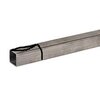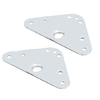All kind of important things are bolted on vehicles. How are your engine, wheels and forks held on? How are tow bars fitted to cars? What about that prop shaft coupling? Plus just about every motorcycle subframe is bolted to the main frame. Nuff said.
What is important is to use the correct size and strength. Plus the correct locking nuts.
Bolts are good, they're everywhere. Unless you intend pulling 40 tons and never carry out inspection, keep it simple. A great way to check for tightness, either a tap with a light hammer or a dedicated torque checker paint. Or both.
Upt.
By the way the semi trailer hitches...yes....bolted. Or they were.
What is important is to use the correct size and strength. Plus the correct locking nuts.
Bolts are good, they're everywhere. Unless you intend pulling 40 tons and never carry out inspection, keep it simple. A great way to check for tightness, either a tap with a light hammer or a dedicated torque checker paint. Or both.
Upt.
By the way the semi trailer hitches...yes....bolted. Or they were.







